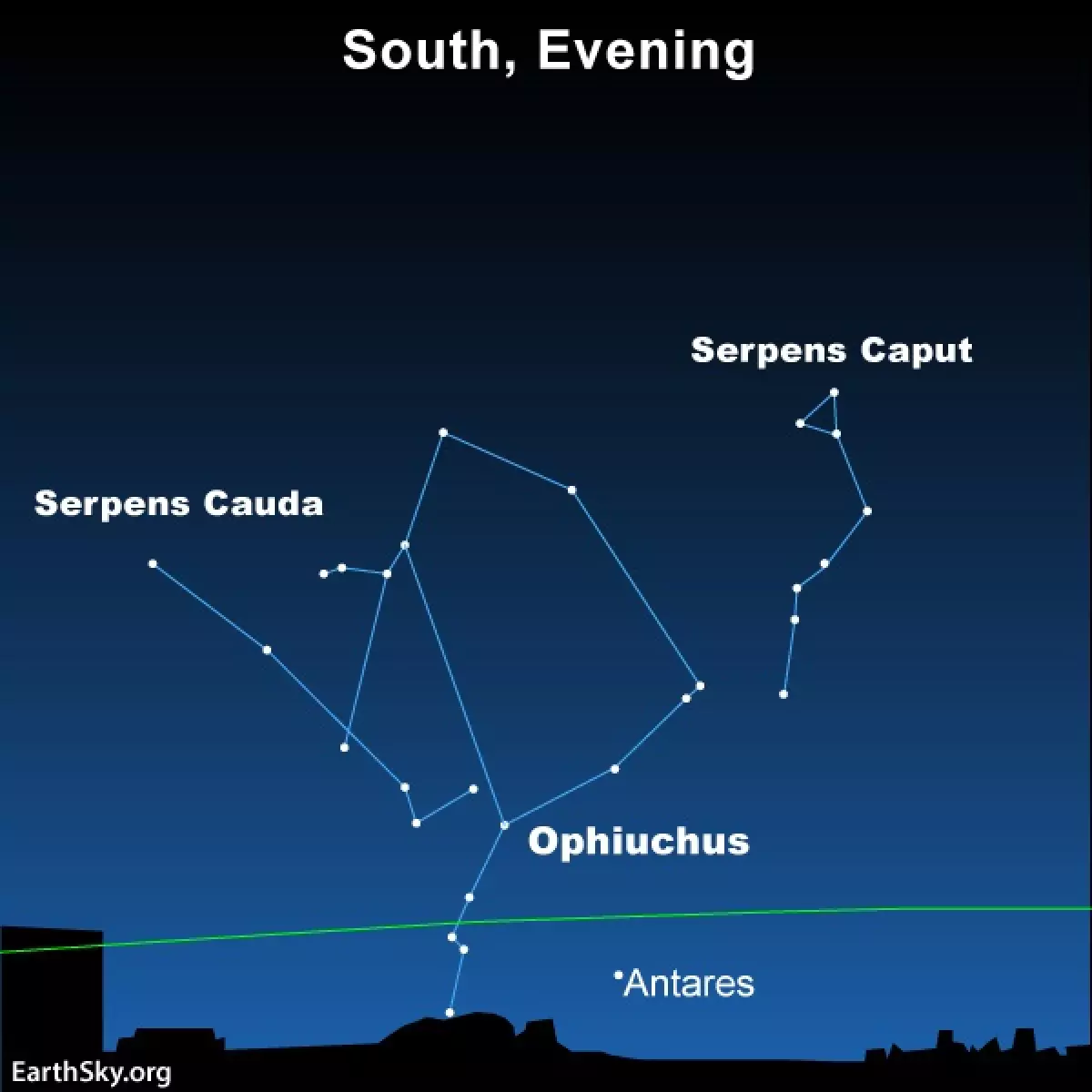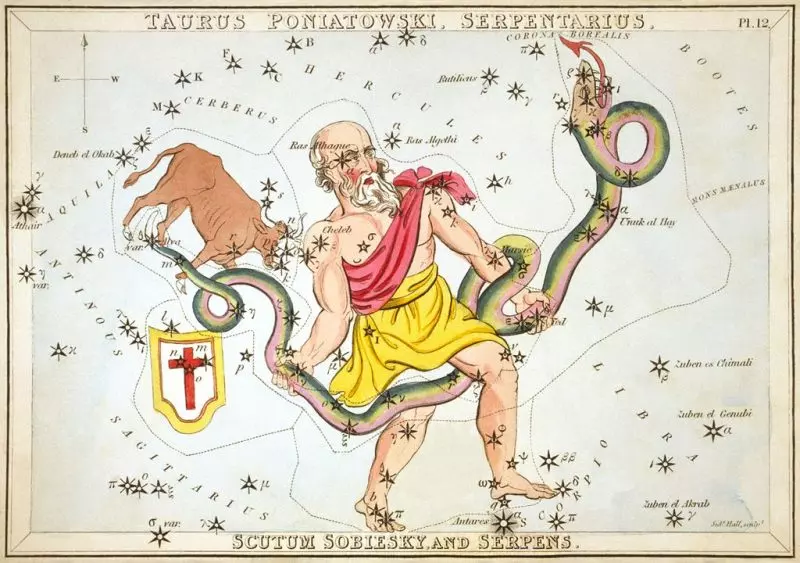 If you’re in the Northern Hemisphere, look southward on July, August or September evenings for mighty Ophiuchus the Serpent Bearer. Chart via Chelynne Campion/ EarthSky.
If you’re in the Northern Hemisphere, look southward on July, August or September evenings for mighty Ophiuchus the Serpent Bearer. Chart via Chelynne Campion/ EarthSky.
Ophiuchus, the Unofficial 13th Constellation of the Zodiac
Have you ever wondered if there's more to the zodiac than the 12 traditional constellations? Well, if you were born between November 30 and December 18, the sun was actually in the constellation Ophiuchus the Serpent Bearer. Despite being a prominent constellation in the night sky, Ophiuchus is not officially recognized as part of the zodiac or included in horoscopes. However, its presence is undeniable, especially if you're in the Northern Hemisphere during the months of July, August, and September.
From the Southern Hemisphere, Ophiuchus is even more prominent, appearing closer to the overhead position. The constellation's brightest star, Rasalhague, stands out in the night sky. Although Ophiuchus is not officially part of the zodiac, it still holds its own significance and beauty.
Signs Versus Constellations
Ophiuchus often gets overlooked in the world of astrology. While the signs of the zodiac are well-known and frequently referenced in online astrology advice, Ophiuchus remains in the shadows. However, it's worth noting that the moon, planets, and even the sun regularly move within the boundaries of this constellation. In fact, the sun itself aligns with Ophiuchus from November 30 to December 18 each year.
The discrepancy arises from the fact that the zodiac signs are based on an ecliptic path, which extends around 8 degrees north and south of the actual ecliptic line. The constellations do not align evenly along this band in our sky, leaving Ophiuchus outside the realm of traditional astrology.
 Ophiuchus holding the serpent, Serpens, as depicted in Urania’s Mirror, a set of constellation cards published in London circa 1825. Image via Adam Cuerden/ Wikipedia (public domain).
Ophiuchus holding the serpent, Serpens, as depicted in Urania’s Mirror, a set of constellation cards published in London circa 1825. Image via Adam Cuerden/ Wikipedia (public domain).
When and Where to Locate Ophiuchus
If you're eager to spot Ophiuchus in the night sky, the best time to observe it is during the Northern Hemisphere summer or Southern Hemisphere winter. Late July and early August offer optimal viewing opportunities from the Northern Hemisphere, with the constellation high in the southern sky during nightfall and early evening. As autumn approaches, Ophiuchus can be found in the southwest sky.
To locate Ophiuchus, simply look north of the constellation Scorpius the Scorpion and south of Hercules the Strongman. If you're already familiar with Scorpius' brightest star, Antares, you can easily navigate to Ophiuchus from there. The head of Ophiuchus is marked by the star Rasalhague (Alpha Ophiuchi).
Ophiuchus is often associated with the constellation Serpent. When the sky is dark enough, you might even be able to observe this constellation resembling its namesake - a big guy holding a snake. The name Ophiuchus itself comes from Greek words meaning "serpent" and "holding."
Deep-Sky Objects in Ophiuchus
On a night when the moon is absent, grab your binoculars and explore Ophiuchus. This constellation lies near the band of the Milky Way, offering a plethora of deep-sky wonders. Ophiuchus is home to numerous globular clusters, such as the easily visible M10 and M12. These clusters may appear as faint puffs of light through binoculars, but when observed with a telescope, their true nature as immense stellar cities becomes apparent, teeming with hundreds of thousands of stars.
Another notable feature is the Pipe Nebula, a vast interstellar cloud of gas and dust spanning about 7 degrees of the sky. With a transparent and dark sky, you can even see it with the naked eye. The Pipe Nebula resides to the east of Antares and north of the stars Shaula and Lesath.
Ophiuchus in Myth and Star Lore
In Greek mythology, Ophiuchus represents Asclepius, the god of medicine and doctors. Asclepius is always depicted holding a great serpent or snake. The snake's venom is believed to have healing properties, capable of both curing and killing. According to the myth, Asclepius created a healing potion using the venom of Serpens the Serpent, mixed with a Gorgon's blood and an unknown herb. This potion granted humans access to immortality, until it caught the attention of Pluto, the god of the underworld.
Pluto appealed to Zeus, the king of the gods, highlighting the potential consequences of eternal life. Zeus ultimately confiscated the potion, removed Asclepius from Earth, and placed him in the starry heavens. The Staff of Asclepius, the symbol of the World Health Organization and other medical organizations, serves as a tribute to this myth and echoes the celestial shape of Ophiuchus the Serpent Bearer.
Ophiuchus in History and Science
Ophiuchus has played a significant role in human understanding of the universe. In 1604, a supernova known as Kepler's Supernova exploded in southern Ophiuchus, becoming visible to the naked eye for an extended period of 18 months. This event, following the earlier Tycho's Supernova in 1572, shattered the prevailing Aristotelian view of an unchanging universe beyond the moon's orbit.
Tycho Brahe's measurements of the distance to both the 1572 supernova and a comet in 1577 provided evidence against the notion of gases burning in the atmosphere. These discoveries challenged Aristotle's immutable universe and paved the way for a more accurate understanding of the cosmos.
In conclusion, while Ophiuchus may not be officially recognized as the 13th constellation of the zodiac, its presence in the night sky is undeniable. Whether you're an astrology enthusiast or simply a stargazing aficionado, exploring Ophiuchus and its deep-sky wonders can be a fascinating and rewarding experience.
The Constellations of the Zodiac
- Aries the Ram
- Taurus the Bull
- Gemini the Twins
- Cancer the Crab
- Leo the Lion
- Virgo the Maiden
- Libra the Scales
- Scorpius the Scorpion
- Sagittarius the Archer
- Capricornus the Sea-goat
- Aquarius the Water Bearer
- Pisces the Fish
Enjoying EarthSky? Sign up for our free daily newsletter today!







